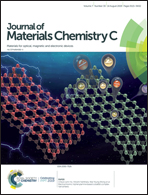Biaxial strain induced band transition and valley–spin coupling in the ferromagnetic semiconducting WSe2/1T-FeCl2 heterostructure
Abstract
The structural and electronic properties of the WSe2/1T-FeCl2 heterostructure have been investigated by density functional theory and Berry curvature calculations. The heterostructure is a magnetic semiconductor with type-II band alignment (0.35 eV band gap) and a magnetic moment of 3.872 μB per unit cell, and it has a high Curie temperature of 816 K and the different magnetic configurations were calculated. In addition, the two layers of the heterostructure couple with each other by van der Waals forces based on Bader charge analysis. Biaxial strain causes a transition of the band alignment from type-II to type-I, and it also leads to a significant change in the work function. Under compression strains of −2% to −8%, the electronic band of the heterostructure shows valley-contrasting character and valley–spin coupling, like monolayer WSe2. The Berry curvature and spin splitting are opposite at the K and K′ valleys, so the valleys and spins are simultaneously locked and polarized, and the valley Hall effect and the spin Hall effect simultaneously occur.



 Please wait while we load your content...
Please wait while we load your content...